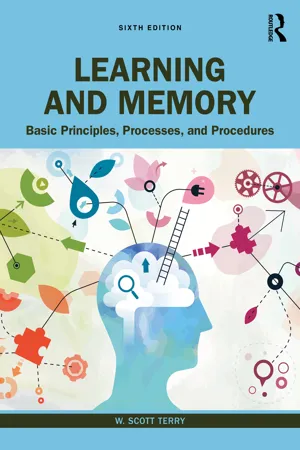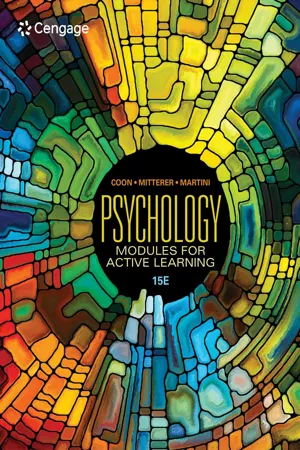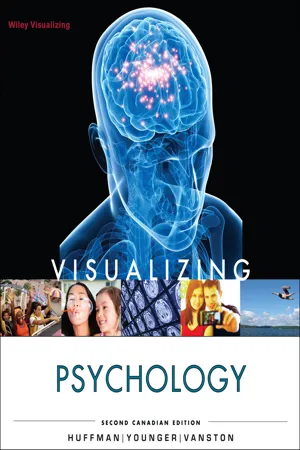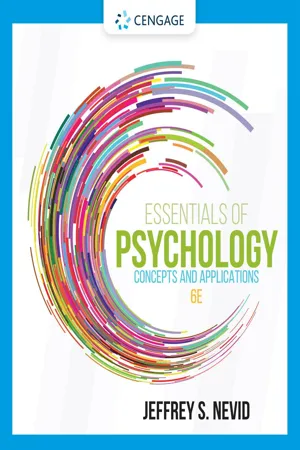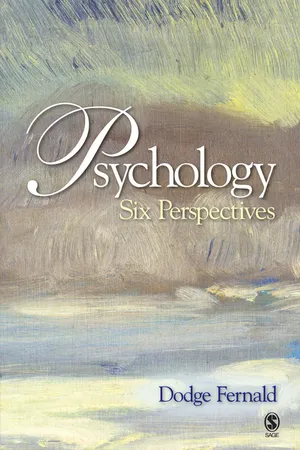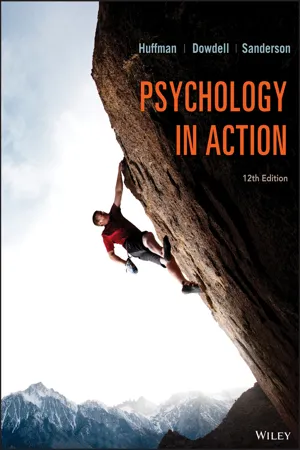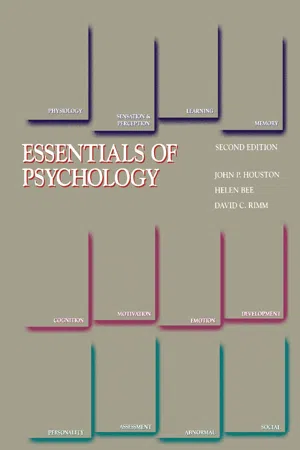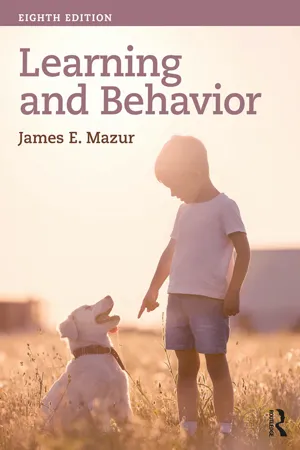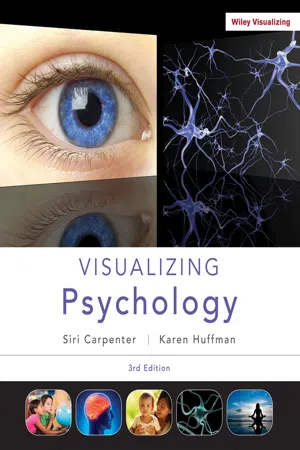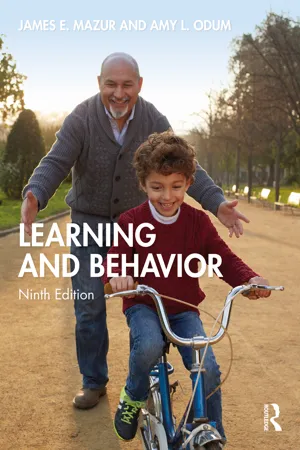Psychology
Application of Classical Conditioning
The application of classical conditioning involves using the principles of association between stimuli to modify behavior. This can be seen in various therapeutic techniques, such as systematic desensitization for treating phobias, and in advertising and marketing to create positive associations with products. Classical conditioning has also been applied in animal training, particularly in the field of behaviorism.
Written by Perlego with AI-assistance
Related key terms
1 of 5
12 Key excerpts on "Application of Classical Conditioning"
- eBook - ePub
Learning and Memory
Basic Principles, Processes, and Procedures
- W. Scott Terry(Author)
- 2023(Publication Date)
- Routledge(Publisher)
Hollis, 1997 ). The application to areas such as drug dependence and tolerance connect conditioning research to the field of health psychology. And classical conditioning offers model systems for neuroscientists to study the biology of learning, on biological levels from synapses to genetics.Possibly foremost among our reasons for studying classical conditioning is to study associative learning. Association refers to the connections that are formed between the internal representations of events, such as stimuli and responses. A simple illustration is word association. The word TABLE often evokes CHAIR as a response. But how are associations formed? Classical conditioning is one tool to study the conditions under which associative learning occurs.The Definition of Classical Conditioning
Simply put, a neutral stimulus, such as a tone, is paired with a significant stimulus, such as food or shock. The development of a new response to the neutral stimulus (such as salivation during the tone) indicates learning. This is more-or-less the definition you learned in Psychology 101. In actual practice, classical conditioning includes a number of variations and violations of the definition. The learning that occurs in classical conditioning can be described on several levels: behavioral, as the learning of a new response; cognitive, as the acquisition of knowledge about the relationship between stimuli; or neural, as the pattern of synaptic changes that underlie conditioning.Say we are to perform an experiment in which mild but aversive electric shocks are to be presented randomly in time. Because of our ethical discomfort with shocking animals or college students, let us suppose the participants are all faculty in the Economics Department. The shocks, delivered to the participants’ forearm, are unavoidable, but our participants would desperately like to know when each is about to occur. We sound a tone for a few seconds before each shock. What will the participants learn? After several pairings of tone followed by shock, the tone will probably come to elicit a behavioral reaction of hand flexion; physiological reactions such as muscular tensing or bracing; and verbalizable knowledge of the tone–shock relationship. - eBook - PDF
Psychology
Modules for Active Learning
- Dennis Coon, John Mitterer, Tanya Martini, , Dennis Coon, John Mitterer, Tanya Martini, (Authors)
- 2021(Publication Date)
- Cengage Learning EMEA(Publisher)
Cengage Learning reserves the right to remove additional content at any time if subsequent rights restrictions require it. 231 MODULE 27 CONDITIONING AND LEARNING: CLASSICAL CONDITIONING Learning Any relatively permanent change in knowledge or behav-ior that can be attributed to experience. Associative learning The formation of simple associations between various stimuli and responses. Classical conditioning A form of learning in which reflex responses are associated with new stimuli. animal forms a simple association among various stimuli, behaviors, or both. Associative learning requires little or no awareness or thought (Everitt & Robbins, 2016). For early psychologists, such as Ivan Pavlov, John Watson, and Edward Thorndike (see Module 3), associative learning was a fairly mechanical process of “stamping in” associa-tions between objective stimuli and objective responses, or behaviors (Henley, 2019). There are two types of associative learning: Classical con-ditioning (which we’ll learn about in this module) and op-erant (or instrumental) conditioning (which is the subject of Module 28). It is worth understanding both forms of associa-tive learning because they help us make sense of much animal and human behavior. In later modules, we’ll also discuss other ways by which people learn, including observational learning (Module 29) and cognitive learning (Module 30). Classical Conditioning—The Nobel Drool Learning Outcome 27.2 Explain how classical condition-ing works, distinguish between extinction and spontaneous recovery as well as between stimulus generalization and stimulus discrimination, and name four instances of classical conditioning in everyday life At the beginning of the 20th century, something happened in the lab of Russian physiologist Ivan Pavlov that gained him the Nobel Prize: His subjects drooled at him. By itself this wasn’t too surprising—after all, Pavlov was studying diges-tion by putting dogs in harnesses and placing food on their tongues. - eBook - PDF
- Karen R. Huffman, Alastair Younger, Claire Vanston(Authors)
- 2013(Publication Date)
- Wiley(Publisher)
What does a salivating dog have to do with your life? Classical conditioning is the most fundamental way that all animals, including humans, learn many new respons- es, emotions, and attitudes. Your love for your parents (or boyfriend or girlfriend), your drooling at the sight of learning A relatively permanent change in behaviour or mental processes because of practice or experience. classical conditioning Learning that occurs when a neutral stimulus (NS) is paired (associated) with an unconditioned stimulus (UCS) to elicit a conditioned response (CR). conditioning The process of learning associations between environmental stimuli and behavioural responses. PROCESS DIAGRAM Pavlov’s classical conditioning • Figure 6.1 THE PLANNER ✓ ✓ Before conditioning The neutral stimulus (NS) produces no relevant response. The unconditioned (unlearned) stimulus (UCS) elicits the unconditioned response (UCR). During conditioning The neutral stimulus (NS) is repeatedly paired with the unconditioned (unlearned) stimulus (UCS) to produce the unconditioned response (UCR). Summary An originally neutral stimulus (NS) becomes a conditioned stimulus (CS), which elicits a conditioned response (CR). After conditioning The neutral stimulus (NS) has become a conditioned (learned) stimulus (CS). This CS now produces a conditioned (learned) response (CR), which is usually similar to the previously unconditioned (unlearned) response (UCR). - eBook - PDF
Essentials of Psychology
Concepts and Applications
- Jeffrey Nevid(Author)
- 2021(Publication Date)
- Cengage Learning EMEA(Publisher)
You can think of classical conditioning as learn- ing by association. If you associate the sound of a dentist’s drill with pain because of past dental treatment, the sound of the drill will probably cause you to respond with the muscle tension that is a natural reflex to pain. If you associate a certain bakery with a particularly tasty treat, you may find yourself salivating simply by driv- ing by the bakery. In other words, you learn to connect or associate two stimuli—the sound of the dental drill and pain, for instance (Chance, 2009). Although classical conditioning is a relatively simple form of learning, it plays important roles in our lives—as you will see in this module. Principles of Classical Conditioning Pavlov performed many experiments in classical conditioning. In a typical experi- ment, he harnessed dogs in an apparatus similar to the one shown in ■ Figure 5.1. When food is placed on a dog’s tongue, the dog naturally salivates. This reflex- ive behavior is called an unconditioned response (UR or UCR) (unconditioned means “unlearned”). A stimulus that elicits an unconditioned response—in this case, the dog’s food—is called an unconditioned stimulus (US or UCS). ■ Figure 5.2 outlines the steps involved in a Pavlovian experiment. As you can see in ■ Figure 5.2(b), the introduction of a neutral stimulus (NS), such as the tone CONCEPT 5.1 Pavlov’s discovery that dogs would salivate to particular sounds in his laboratory led him to identify a process of learning called classical conditioning. Copyright 2022 Cengage Learning. All Rights Reserved. May not be copied, scanned, or duplicated, in whole or in part. Due to electronic rights, some third party content may be suppressed from the eBook and/or eChapter(s). Editorial review has deemed that any suppressed content does not materially affect the overall learning experience. Cengage Learning reserves the right to remove additional content at any time if subsequent rights restrictions require it. - eBook - PDF
Psychology
Six Perspectives
- Dodge Fernald(Author)
- 2007(Publication Date)
- SAGE Publications, Inc(Publisher)
Classical Conditioning Principles Principles of classical conditioning are widely used to explain the develop-ment of emotional reactions in everyday life. On passing a tree from which she fell as a youth and sustained serious injury, an elderly woman still shudders a bit. A man enjoys a slight flash of excitement on walking in a park where he encountered his first love on summer evenings. Someone who becomes violently nauseous while dining at a certain restaurant or using a certain medication tends to re-experience some of that illness on confronting the relevant stimulus again. Classically conditioned responses of this sort appear throughout daily life. Within psychology, no other theory or perspective offers an equally com-pelling explanation of unusual, individually acquired fears and preferences. Sometimes a stimulus that is merely similar to the conditioned stimulus elicits the conditioned response, an outcome called stimulus generalization . The new stimulus is not the same as the conditioned stimulus—but is enough like it to call forth the response. A cabinet similar to Bertha’s Biedermeier might evoke a positive emotional response in her. A setting similar to their soup kitchen might have elicited a positive emotional response among the refugees. The little girl who became fearful of doctors’ long, white coats one day was taken to a restaurant and observed the waiters wearing short, white coats. But the length did not matter. Immediately, she started crying and screaming. Stimulus generalization had occurred. The short, white coats were enough like long, white coats to elicit the fear reaction (Fernald, 1997). That was the long and short of it. As a rule, the individual eventually learns the difference between relevant and irrelevant stimuli, such as long and short coats. The process of respond-ing only to the correct stimulus, and not to others that appear similar, is called discrimination . - eBook - PDF
- Karen R. Huffman, Katherine Dowdell, Catherine A. Sanderson(Authors)
- 2017(Publication Date)
- Wiley(Publisher)
In Chapter 15, you’ll discover how Watson’s research later led to powerful clinical tools for eliminating exaggerated and irrational fears of a specific object or situation, known as phobias (Cheng et al., 2017; Pear, 2016). For more examples of how classical conditioning impacts everyday life, see Concept Organizer 6.1. a. Prejudice How do children, like the one holding the KKK sign in this photo, develop prejudice at such an early age? Research shows that prejudice may be a com- bination of psychological, biological, and cultural factors (Conger et al., 2012; Hughes et al., 2016; Mallan et al., 2013). As shown in the diagram, children are naturally upset and fearful (UR) when they see that their parents are upset and afraid (US). Over time, they may learn to associate their parents’ reaction with all members of a disliked group (CS), thus becoming prejudiced like their parents. b. Advertising Magazine ads, TV commercials, and business promo- tions often use both basic and higher- order classical conditioning to pair their products or company logo, the neutral stimulus (NS), with previously conditioned pleasant images, like celebrities, the conditioned stimulus (CS). These images then trigger desired behaviors, the conditioned response (CR), such as purchasing the advertised products (Chen et al., 2014; Hing et al., 2015; van der Pligt & Vliek, 2016). c. Medicine Classical conditioning also is used in the medical field. For example, a treat- ment designed for alcohol-addicted patients pairs alcohol with a nausea-producing drug. Afterward, just the smell or taste of alcohol makes the person sick. Some, but not all, patients have found this treatment helpful. d. Politics Politicians often use classical conditioning to create a positive conditioned emotional response (CER) toward themselves and/or a negative CER against their opponents. - eBook - PDF
- John P. Houston, Helen Bee, David C. Rimm(Authors)
- 2013(Publication Date)
- Academic Press(Publisher)
CHAPTER FOUR Learning and conditioning A definition of learning Classical conditioning Pavlov's experiments Quiz panic, Christmas bells, and autumn leaves The four elements of classical conditioning Temporal arrangements of the CS and UCS Further laboratory examples Classical conditioning of human emotions Phobias Masochism Instrumental conditioning Three types of instrumental conditioning Positive reinforcement, negative reinforcement, and punishment Shaping Classical and instrumental conditioning compared: biofeedback and reinforcement Voluntary versus involuntary Reinforcement versus no reinforcement Verbal learning Free-recall learning Serial and paired-associate learning Verbal learning and conditioning compared Basic conditioning and learning phenomena Acquisition Extinction Spontaneous recovery Stimulus generalization Discrimination Reinforcement Delay of reinforcement Amount of reinforcement Schedules of reinforcement Partial reinforcement and the extinction effect Secondary reinforcement Transfer of training Learning by observing models Biological limits Bait shyness Preparedness Species spécifie defense reactions (SSDRs) Instinctive drift Summary Key terms Learning is vital to all higher forms of life. Without the capacity to learn, or to modify our behavior in accordance with our experiences, we would not survive. We would not be able to speak or to communicate through the use of language, as those skills appear to be learned and not innate. You would not be reading this text, as you would not have learned to read (and we wouldn't have learned to write). No one would drive automobiles, live in houses, catch planes, or go to college. Our emotional, social, sex-ual, intellectual, and physical worlds would be entirely different from what they are now. Without the capacity to learn our lives would be incredibly limited (and short, too). Spend a moment imagining what our lives would be without the ability to profit from experience. - eBook - PDF
- Matthew H. Olson, Julio J. Ramirez(Authors)
- 2020(Publication Date)
- Routledge(Publisher)
Such a definition still stresses the importance of experience but leaves it to the theorist to specify the kind of experience the theorist feels is necessary for learning to take place. These might include, for example, reinforced practice, contiguity between a stimulus and a response, or the acquisition of information. It also reminds us that experience results in processes other than learning, fatigue for example, that modify behavior. ARE THERE DIFFERENT KINDS OF LEARNING? Learning , as we have seen, is a general term that is used to describe changes in behavior potentiality resulting from experience. Conditioning , however, is a more specific term used to describe actual procedures that modify behavior. Because there are two kinds of conditioning, instrumental and classical , many theorists conclude that there are at least two kinds of learning or that learning ultimately can be understood in terms of classical and instrumental conditioning. Although both conditioning procedures are discussed in detail later on in this book, we summarize both procedures here briefly. CLASSICAL CONDITIONING We look at classical conditioning in detail when we discuss Pavlov’s views on learning in Chapter 7, but for now we can summarize classical conditioning as follows: 1. A stimulus, such as food, is presented to an organism and will cause a natural and automatic reaction, such as salivating. The stimulus causing this natural reaction is called the unconditioned stimulus (US). In this case, the food is the US. The natural, automatic reaction to the US is called the unconditioned response (UR). In this case, salivation is the UR. Gregory A. Kimble. Source : Duke University Archives. 9 WHAT IS LEARNING? 2. A neutral stimulus (one that does not cause a UR), such as a tone or light, is presented to the organism just prior to the presentation of the US. This neutral stimulus is called the conditioned stimulus (CS). - eBook - ePub
Learning & Behavior
Eighth Edition
- James E. Mazur(Author)
- 2016(Publication Date)
- Routledge(Publisher)
Chapter 3 Basic Principles of Classical ConditioningLearning ObjectivesAfter reading this chapter, you should be able to- describe the procedure of classical conditioning and some of the most common ways it is studied in the laboratory
- explain Pavlov’s stimulus substitution theory, and describe its strengths and weaknesses
- describe the basic principles of classical conditioning, including acquisition, extinction, spontaneous recovery, conditioned inhibition, generalization, and discrimination
- explain how the timing of the stimuli in classical conditioning affects the results
- give examples of classical conditioning that are found in everyday life
- describe some behavior therapies that are based on classical conditioning, and evaluate their effectiveness
Pavlov’s Discovery and Its Impact
The Russian scientist Ivan Pavlov is one of the most famous figures in the history of psychology. Pavlov was interested in the various substances secreted by an animal’s digestive system to break down the food eaten, including saliva. He used dogs in his research, and he developed a surgical technique that enabled him to redirect the saliva from one of the dog’s salivary ducts through a tube and out of the mouth, so that it could be measured (see Figure 3.1 ). A dog might receive several test sessions on successive days. In each session the animal would be given food, and its salivation would be recorded as it ate. Pavlov’s important observation came when studying dogs that had been through the testing procedure several times. Unlike a new dog, an experienced one would begin to salivate even before the food was presented. Pavlov reasoned that some stimuli that always preceded the presentation of food, such as the sight of the experimenter, had developed the ability to elicit the response of salivation. Pavlov concluded that his dogs were exhibiting a simple type of learning: Salivation, which began as a reflexive response to the stimulus of food in the dog’s mouth, was now elicited by a new stimulus. This phenomenon is now known as classical conditioning - eBook - PDF
- Siri Carpenter, Karen Huffman(Authors)
- 2012(Publication Date)
- Wiley(Publisher)
Psychologists would say these are learned behaviors. In this chapter, we begin with a focus on two of the most basic forms of learning— clas-sical and operant conditioning . Then we look at social-cogni-tive learning and the biologi-cal factors involved in learn-ing. Throughout the chapter we explore how learning theories and concepts im-pact our everyday lives. s you can see from our opening examples of gambling and service dogs, psychologists de-fine learning in a broad way that emphasizes a relatively permanent change, as opposed to the short-term “learning” that often occurs when you’re passively listening to lectures or studying a text. This relative per-manence applies not only to use-ful behaviors (guiding the blind, reading this text) but also to bad habits, like gambling or texting while driving a car. The good news is: What is learned can be unlearned. We begin this chapter with a study of one of the earli-est forms of learning, classical conditioning , made famous by Pavlov’s salivating dogs. Beginnings of Classical Conditioning Why does your mouth water when you see a large slice of chocolate cake or a juicy steak? The answer to this question was accidentally discovered in the laboratory of Russian physiologist Ivan Pavlov (1849–1936). Pav-lov’s work focused on the role of saliva in digestion, and one of his experiments involved measuring salivary re-sponses in dogs, using a tube attached to the dogs’ sali-vary glands. One of Pavlov’s students noticed that many dogs be-gan salivating at the sight of the food or the food dish, the smell of the food, or even the sight of the person who de-livered the food long before receiving the actual food. This “unscheduled” salivation was intriguing. Pavlov recog-nized that an involuntary reflex (salivation) that occurred before the appropriate stimulus (food) was presented could not be inborn and biological. It had to have been acquired through experience—through learning . - eBook - ePub
- James E. Mazur, Amy L. Odum(Authors)
- 2023(Publication Date)
- Routledge(Publisher)
CHAPTER 3 Basic Principles of Classical ConditioningDOI: 10.4324/9781003215950-3Learning ObjectivesAfter reading this chapter, you should be able to- describe the procedure of classical conditioning and some of the most common ways it is studied in the laboratory
- explain Pavlov’s stimulus substitution theory and describe its strengths and weaknesses
- describe the basic principles of classical conditioning including acquisition, extinction, spontaneous recovery, conditioned inhibition, generalization, and discrimination
- explain how the timing of the stimuli in classical conditioning affects the results
- give examples of classical conditioning that are found in everyday life
- describe some behavior therapies that are based on classical conditioning and evaluate their effectiveness.
Pavlov’s Discovery and Its Impact
The Russian scientist Ivan Pavlov is one of the most famous figures in the history of psychology. Pavlov was interested in the various substances secreted by an animal’s digestive system to break down the food eaten, including saliva. He used dogs in his research, and he developed a surgical technique that enabled him to redirect the saliva from one of the dog’s salivary ducts through a tube and out of the mouth so that it could be measured (see Figure 3.1 ). A dog might receive several test sessions on successive days. In each session the animal would be given food, and its salivation would be recorded as it ate. Pavlov’s important observation came when studying dogs that had been through the testing procedure several times. Unlike a new dog, an experienced one would begin to salivate even before the food was presented. Although it was not the focus of his research originally, Pavlov noticed this curious phenomenon and began to study it. Pavlov reasoned that some stimuli that always preceded the presentation of food, such as the sight of the experimenter, had developed the ability to elicit the response of salivation. Pavlov concluded that his dogs were exhibiting a simple type of learning: Salivation, which began as a reflexive response to the stimulus of food in the dog’s mouth, was now elicited by a new stimulus. This phenomenon is now known as classical conditioning - eBook - PDF
- Douglas Bernstein, , , (Authors)
- 2015(Publication Date)
- Cengage Learning EMEA(Publisher)
© Wei Ming/Shutterstock.com IN REVIEW BASIC PROCESSES OF CLASSICAL CONDITIONING Process Description Example Acquisition A neutral stimulus and an unconditioned stimulus (UCS) are paired. The neutral stimulus becomes a conditioned stimulus (CS), eliciting a conditioned response (CR). A child learns to fear (conditioned response) the doctor’s office (conditioned stimulus) by associ-ating it with the automatic emotional reaction (unconditioned response) to a painful injection (unconditioned stimulus). Stimulus generalization A conditioned response is elicited not only by the conditioned stimulus but also by stimuli similar to the conditioned stimulus. A child fears most doctors’ offices and places that smell like them. Stimulus discrimination Generalization is limited so that some stimuli similar to the conditioned stimulus do not elicit the conditioned response. A child learns that his mother’s doctor’s office is not associated with the unconditioned stimulus. Extinction The conditioned stimulus is presented alone, without the unconditioned stimulus. Eventu-ally the conditioned stimulus no longer elicits the conditioned response. A child visits the doctor’s office several times for a checkup but does not receive a shot. Fear may eventually cease. Review Questions 1. If a person with a conditioned fear of spiders is also frightened by the sight of creatures that look somewhat like spiders, the person is demonstrating stimulus _ . 2. Because of _ , we are more likely to learn a fear of snakes than a fear of cars. 3. Feeling sad upon hearing a song associated with a long-lost relationship illustrates _ . Copyright 2016 Cengage Learning. All Rights Reserved. May not be copied, scanned, or duplicated, in whole or in part. Due to electronic rights, some third party content may be suppressed from the eBook and/or eChapter(s). Editorial review has deemed that any suppressed content does not materially affect the overall learning experience.
Index pages curate the most relevant extracts from our library of academic textbooks. They’ve been created using an in-house natural language model (NLM), each adding context and meaning to key research topics.
